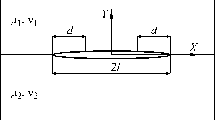Abstract
The calculation of the energy release rate of a debonding interface crack between fiber and matrix in plane strain requires a knowledge of the stress state and displacements at the neighbourhood of the crack tip. Analytical solutions which involve interpenetrations of the free boundaries of the fiber and matrix have classically been used to predict the variation of the energy release rate with the debonding angle. In this paper a numerical study of this problem as a contact problem, using Boundary Elements, is carried out. The singular stress components are modelled by means of singular discontinuous elements, a particular contact algorithm, which is very appropriate for cases like that under consideration where the fiber is much stiffer than the matrix, having been proposed. The numerical procedure shows the appearance of a contact zone with physical meaning starting at a certain value of the debonding angle, which implies the presence of a pure mode II of fracture. The values of G found by BEM are compared with those predicted by the use of an analytical solution showing clear discrepancies when the contact zone starts to develop, BEM always predicting smaller values of the energy release rate, in accordance with the absence of mode I in the presence of a contact zone.
Similar content being viewed by others
References
A.H. England, A Crack Between Dissimilar Media. Journal of Applied Mechanics, June (1965) 400–402.
F. Erdogan, Stress Distribution in Bonded Dissimilar Materials With Cracks, Journal of Applied Mechanics, June (1965) 403–410.
J.R. Rice and G.C. Sih, Plane Problems of Cracks in Dissimilar Media. Journal of Applied Mechanics, June (1965) 418–423.
A.H. England, An Arc Crack Around a Circular Elastic Inclusion. Journal of Applied Mechanics, September (1966) 637–640.
M. Toya, A Crack Along the Interface of a Circular Inclusion Embedded in an Infinite Solid. Journal of the Mechanics and Physics of Solids 22 (1975) 325–348.
M. Comninou, The Interface Crack. Journal of Applied Mechanics 44 (1977) 631–636.
M. Comninou, The Interface Crack in a Shear Field. Journal of Applied Mechanics 45 (1978) 287–290.
M. Comninou and D. Schmueser, The interface crack in a Combined Tension-Compression and Shear Field. Journal of Applied Mechanics 46 (1979) 345–348.
M. Comninou, Interface Crack with Friction in the Contact Zone. Journal of Applied Mechanics, December (1977) 780–781.
A.K. Gautesen and J. Dundurs, The Interface Crack in a Tension Field. Journal of Applied Mechanics 54 (1987) 93–98.
A. K. Gautesen and J. Dundurs, The Interface Crack Under Combined Loading. Journal of Applied Mechanics 55 (1987) 580–586.
F. París and J. Cañas, Boundary Element Method. Fundamentals and Applications. Oxford University Press. In press.
J.C. del Caño and F. París, On Stress Singularities Induced by the Discretization in Some Contact Problems. International Journal of Numerical Methods in Engineering. Accepted for publication.
F. París and J.A. Garrido, An Incremental Procedure for Friction Contact Problems with Boundary Element Method. Engineering Analysis with Boundary Elements 6(4) (1989) 202–213.
J.C. del Caño, Micromechanical Study of the Debonding Between Fiber and Matrix in Composite Materials by means of the Boundary Element Method, PhD Thesis (in Spanish), University of Valladolid, Spain (1995).
J. Varna, L.A. Berglund and M. Ericsson, Interfacial Damage Processes and Test Method for Single Fibre Composites Loaded in Transverse Tension, Part II: Theoretical Modelling and Data Reduction, Submitted to Acta Metallurgica et Materalia (1995).
T. Andersson and B.G. Allan-Persson, Progress in Boundary Elements 2, (5) Ed. by C.A. Brebbia, Pentech Press (1983).
K.W. Man, M.H. Aliabadi and D.P. Rooke, BEM frictional contact analysis: modelling considerations. Engineering Analysis with Boundary Elements 11 (1993) 77–85.
G.R. Irwin, Fracture, Handbuch der Physik, Springer Verlag, Berlin, 5 (1958) 551.
Author information
Authors and Affiliations
Rights and permissions
About this article
Cite this article
París, F., Caño, J.C. & Varna, J. The fiber-matrix interface crack — A numerical analysis using Boundary Elements. Int J Fract 82, 11–29 (1996). https://doi.org/10.1007/BF00017861
Received:
Accepted:
Published:
Issue Date:
DOI: https://doi.org/10.1007/BF00017861




